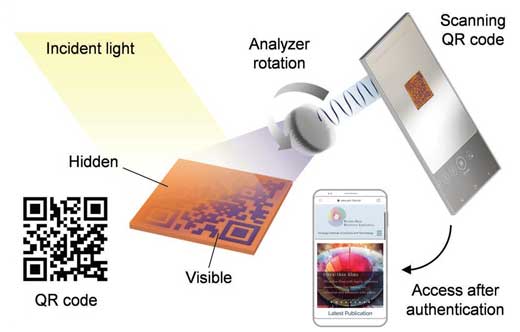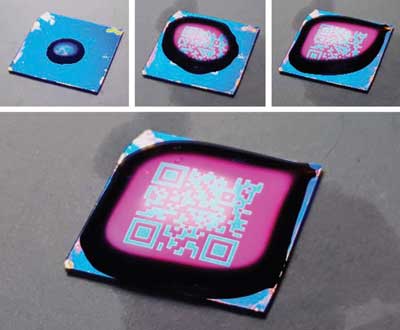| Jan 10, 2020 | |
Scalable and flexible covert polarization displays |
|
| (Nanowerk Spotlight) Most natural and artificial colors are formed due to selective light absorption by pigments or dyes. An alternative mechanism of color formation is the result of frequency-selective light scattering by micro- and nanoscale structures inside a material – so-called structural color. | |
| Researchers have developed numerous applications with structural colors, among them the creation of sophisticated security features for anti-counterfeiting. Covert polarization displays, for instance, provide a barrier to the inadvertent viewing of encrypted optical information without compromising packaging aesthetics. | |
| These polarization sensitive systems, however, have significant limitations with regard to scalability and conformability. This makes them unsuitable for realistic applications of daily life such as banknotes, identity cards, medicine, and consumer goods packaging. | |
| To break through the flexibility/scalability limitation of existing systems, researchers have now developed a large-area covert polarization display technology by using ultrathin lossy nanocolumns deposited on a metal film. | |
| This clever strategy for switching covert optical information uses polarization-dependent multicolors without structurally sophisticated fabrication processes. | |
| This technology, developed by Professor Young Min Song and his Flexible OptoElectronics Lab at Gwangju Institute of Science and Technology, has been reported in Advanced Functional Materials ("Flexible, Large-Area Covert Polarization Display Based on Ultrathin Lossy Nanocolumns on a Metal Film"). | |
 |
|
| Schematic illustration of covert polarization display including optical data (QR code) and series of processes for QR code authentication. (Reprinted with permission by Wiley-VCH Verlag) | |
| As a practical application, exploiting the flexibility and polarization sensitivity of PNCs, the figure above illustrates a schematic of covert polarization display including optical data (e.g., QR code) with a series of processes of the QR code authentication. The covert display is hidden in the observation environment of the naked eye (i.e., unpolarized light), while the stored QR code on the covert display is visible by rotating an analyzer (i.e., linear polarizer) to a predetermined polarization angle. Furthermore, the QR code can be used to authenticate a smartphone user. | |
| According to the team, the most important aspect of their work are the self-aligned porous nanocolumns (PNCs) as a polarization sensitive color filter. The PNCs are deposited on a metal film and aligned by glancing angle deposition. | |
| "We designed theses nanocolumns to switch color in accordance with polarization by ultrathin resonance, which we modeled using the complex effective refractive index," Song tells Nanowerk. | |
| "Conventionally, to implement a polarization distinguishable color filter, highly aligned nanostructures are necessary as an interference system between nanostructure direction and polarization angle," he adds. "For this reason, most existing polarization displays that use aligned nanostructure are fabricated with complicated processes. In our research, using the PNCs, we overcame these limitations." | |
| This video shows how a covert polarization display works even on curved and wrinkled surfaces like a snack bag. here, the QR code stored for authenticating a smartphone user is revealed in polarized light. | |
| In another demonstration of the capabilities of the PNCs, Song's team also developed a multifunctional covert polarization display function as a water contact indicator. | |
| "Due to the low complex effective refractive index, PNCs are sensitive to subtle external refractive index changes, such as water, on the surface of PNCs," Song explains. "With the sensitivity of PNCs to changes in external refractive index, we designed a covert display divided into areas insensitive to and sensitive to water by forming vertical and slanted nanocolumns at different deposition angles (0° and 70°), respectively." | |
 |
|
| Water contact images of multifunctional covert display with water gradually dropped onto the surface. (Reprinted with permission by Wiley-VCH Verlag) | |
| Since this covert polarization display can be fabricated on a scalable, flexible, and ultra-thin medium, it has potential for applications in soft optoelectronics and optical security system. | |
| During this present work, the team demonstrated their covert polarization display with ultra-thin labels attached to daily products such as wine bottles, snack bags, and food containers. In the next stage of their work they will design their displays for optical security systems such as banknotes and electronics. | |
 By
Michael
Berger
– Michael is author of three books by the Royal Society of Chemistry:
Nano-Society: Pushing the Boundaries of Technology,
Nanotechnology: The Future is Tiny, and
Nanoengineering: The Skills and Tools Making Technology Invisible
Copyright ©
Nanowerk LLC
By
Michael
Berger
– Michael is author of three books by the Royal Society of Chemistry:
Nano-Society: Pushing the Boundaries of Technology,
Nanotechnology: The Future is Tiny, and
Nanoengineering: The Skills and Tools Making Technology Invisible
Copyright ©
Nanowerk LLC
|
|
|
Become a Spotlight guest author! Join our large and growing group of guest contributors. Have you just published a scientific paper or have other exciting developments to share with the nanotechnology community? Here is how to publish on nanowerk.com. |
|
